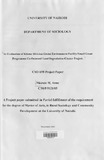| dc.description.abstract | This study was carried out on Kilome land degradation rehabilitation cluster project to explore the community involvement in rehabilitating the degraded land in Mukaa District in the Lower Eastern province in Kenya that suffers lots land degradation. To reverse and prevent further land degradation, Kenya Initiative for Development KID) a local Non- Governmental Organization in the area together with other 10 Community Based Organizations(CBOs) received a financial grant of USD 300 in the year 2006. to implement several community projects aimed at alleviating and restoring the highly degraded land.
Both probability and non-probability sampling techniques were used. The study benefited both from qualitative and quantitative methods of data collection. Semi-structured interviews were administered using a questionnaire to respondents from 107 households. 5 Focused group discussions were held using a focused group discussion guide with 5 CBOs undertaking the projects. A total of nine key informants were interviewed, an interview guide was used. Direct observation method was used to observe physical and economic context which the respondent live, the type of land degradation and what the community was doing to mitigate the same. The community participated in the projects by; (i) building gabions (ii) building check off dams (iii) digging cut off trenches and (iv) planting trees. The project immediate benefits included: improved food security, water, reduction in soil erosion, and increase in household income through the food for work program. Challenges encountered included ;(i) drought, delay in receiving funds, misappropriation of funds and difficult working conditions and group conflicts.
Conservation activities should be broadened and integrated with other pressing community needs. Observation from this study indicate that the success of the project was not necessarily because the community was going for land rehabilitation as such, but they were able to identify solutions for other problems e.g. they dug the cut-off trenches and desilted the existing dams as a way of harvesting water and directing it to dams for future use. It would be important in future to carry out a summative evaluation of the project to establish the long term impacts of the projects to the community. | en_US |

